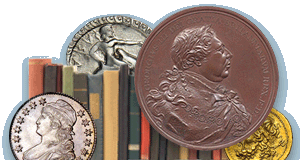
PREV ARTICLE
NEXT ARTICLE
FULL ISSUE
PREV FULL ISSUE
BANK OF CANADA MUSEUM ACQUISITIONSThis post on the Bank of Canada Museum's blog discusses their new acquisitions in 2024. -Garrett Each year the Museum receives dozens of offers from the public to donate or sell objects to the National Currency Collection. Add to that the ever-growing list of objects the curators bring to the acquisition committee's attention to develop the collection. Yet beyond the donations and purchases, items that are otherwise restricted from public ownership can be obtained only from the organizations that are responsible for their manufacture or their seizure. Therefore, it is important for the Museum to have relationships with these organizations. Royal Canadian Mint As the producer and distributor of Canada's coins, the Royal Canadian Mint maintains a strong relationship with the Museum. Over the years, the Mint has transferred its holdings of production tools to the Museum to preserve the Mint's legacy as a leading organization in coin production. The process of minting coins has evolved. Fortunately, the National Currency Collection includes objects that showcase many of the Mint's important milestones. In 2024, the Mint transferred hundreds of master dies and punches to the Museum for long-term preservation and public appreciation. 
In 1981, the Royal Canadian Mint produced this matrix for a commemorative circulating dollar coin to mark the patriation of the Canadian Constitution. Yet the coin was never issued. Instead, a "Voyageur" nickel dollar circulated that year. The Mint did commemorate the adoption of the Constitution Act, 1867 in 1982 with a nickel dollar featuring a reproduction of the Fathers of Confederation painting on its reverse. Source: Canada, Royal Canadian Mint, 1 dollar, coining matrix, Canadian Constitution, 1981 | NCC 2024.17.131. The Rooms The Museum also maintains relationships with other cultural institutions through long-term loan agreements. Sometimes these loans become permanent. Earlier this year, The Rooms in St. John's officially transferred a sheet of Government of Newfoundland treasury notes from its collection to the Museum. Issued in 1850, the £1 notes were among the first examples of paper money to circulate in Newfoundland. They were printed in sheets of four notes, numbered by hand and signed by two commissioners. Today, early Newfoundland notes are very rare. This sheet had been on loan to the Museum since 1974. Though the exact purpose of the original loan is undocumented, it was likely intended to exhibit this unique item in the new Bank of Canada Currency Museum, which was in planning as part of the expansion of the Bank's head office in the mid-1970s. Sheldon Carroll, a former curator of the National Currency Collection, would likely have negotiated the loan from The Rooms through prominent Newfoundland numismatist C. Francis Rowe, who by profession was a meteorologist at St. John's International Airport. Over time, the terms of the loan expired and were never updated until The Rooms contacted the Museum to inquire about the sheet of notes. 
The first paper money for general circulation in Newfoundland was notes of £1 and £5 drawn on the provincial treasury. This sheet of notes is numbered, signed, and ready to be cut and put into circulation. Source: Newfoundland, 1 pound, treasury note, sheet, 1850 | NCC 2024.15.1. And there's always a steady stream of acquisitions from the public Beyond the items acquired from our institutional partners, the National Currency Collection continues to grow each year thanks to public donations and private purchases. Here are some more treasures acquired in 2024. 
Early Canadian scrip is scarce, and this note issued by Barthélemy Joliette, the founder of the town of Joliette, Quebec, enhances the Museum's holdings for future displays and programming. Source: Canada, Barthélemy Joliette, 1 ecu, commercial scrip, 1838 | NCC 2024.10.1. Gift of Louis-Michel Fontaine. Jacob Lipson, owner of Jacob Lipson Rare Coins and president of the Ottawa Numismatics Society, provided some comments on the collection of dies in a news article. -Garrett "Everyone is going to have their own interests, but the most interesting things listed in the blog post for me are the hundreds of Royal Canadian Mint master dies," Lipson said. "These dies are used to strike circulation and non-circulating collector coins." "The transfer that we got from the Royal Canadian Mint was a very important acquisition," Bergeron said. "Because it contains hundreds of working dies and things related to the production of money. The dies themselves are all unique."
To read the complete article, see:
Wayne Homren, Editor The Numismatic Bibliomania Society is a non-profit organization promoting numismatic literature. See our web site at coinbooks.org. To submit items for publication in The E-Sylum, write to the Editor at this address: whomren@gmail.com To subscribe go to: Subscribe All Rights Reserved. NBS Home Page Contact the NBS webmaster 
|
